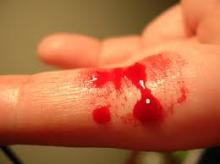Tailored frequency-escalated prophylaxis produced good outcomes with little arthropathy among boys with hemophilia A, according to findings from a prospective study.
The potential to use smaller amounts of clotting factor concentrates (CFCs) also offers a possible cost savings, Brian M. Feldman, MD, of the Hospital for Sick Children, Toronto, and his colleagues reported in the Lancet Haematology.
Prophylactic treatment to prevent bleeding episodes and avoid long term complications using regular CFCs is very effective but also very expensive. The Canadian Hemophilia Prophylaxis Study (CHPS) began 2 decades ago with the premise that, since CFC use accounts for most of the financial burden in severe hemophilia and because primary prophylaxis is started at a very young age, the burden on both the patient and the health care system could potentially be reduced by starting prophylaxis with CFC infusions at reduced frequency intervals. The individual’s subsequent bleeding episodes would then determine how the dose and frequency could be tailored.
In the study, 56 boys between the ages of 1 and 2.5 years with severe hemophilia A from 12 Canadian centers were enrolled in the CHPS, with a median time in the study of 10.2 years. Treatment was with standard half-life recombinant factor VIII (SHL-rFVIII), beginning as once weekly prophylaxis with 50 IU/kg and then escalating in frequency with appropriate dose adjustments as needed (step 1). The primary endpoint for this analysis was joint health, as measured by the modified Colorado Child Physical Examination Scores at completion of the study.
Participants were able to stay on once a week prophylaxis, without unacceptable bleeding, until a median age of 4.5 years. At this time, boys who developed unacceptable bleeding were escalated to twice-weekly prophylaxis at 30 IU/kg (step 2). The median age for beginning alternate day prophylaxis at 25 IU/kg (step 3) was 9.9 years of age.
The median annual SHL-rFVIII use was 3,582 IU/kg at age 2 years (n = 56), 4,041 IU/kg at age 6 years (n = 53), 3,638 IU/kg at age 10 years (n = 40), and 3,663 IU/kg at 14 years of age (n = 18). Overall adherence to the tailored regimen was a median of 86%, and no treatment-related safety events were observed during the study, including central venous catheter infections.
The median use of SHL-rFVIII on the tailored frequency-escalated prophylaxis is considerably less than the 6,000 IU/kg per year used in standard prophylaxis regimens, the researchers noted.


